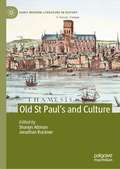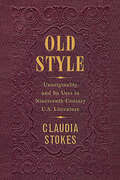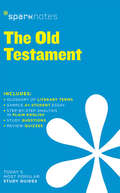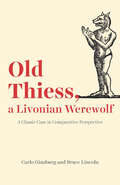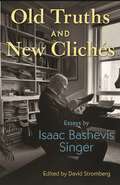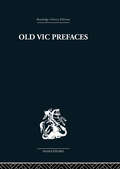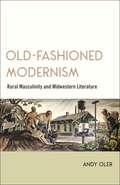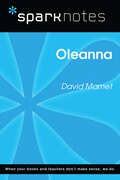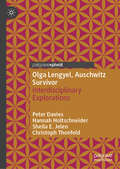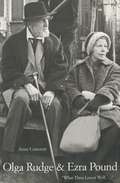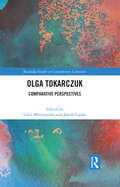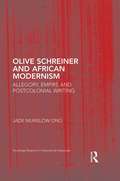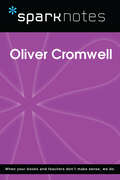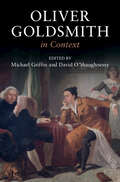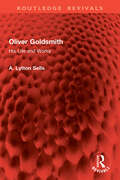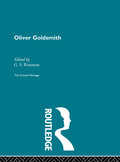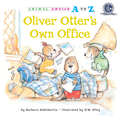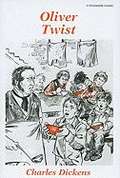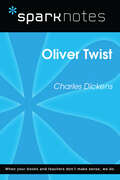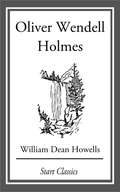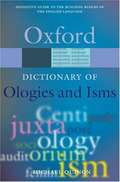- Table View
- List View
Old St Paul’s and Culture (Early Modern Literature in History)
by Shanyn Altman Jonathan BucknerOld St Paul’s and Culture is an interdisciplinary collection of essays that looks predominantly at the culture of Old St Paul’s and its wider precinct in the early modern period, while also providing important insights into the Cathedral’s medieval institution. The chapters examine the symbolic role of the site in England’s Christian history, the London book trade based in and around St Paul’s, the place of St Paul’s commercial indoor playhouse within the performance culture of sixteenth and seventeenth-century London, and the intersection of religion and politics through events such as civic ceremonies and occasional sermons. Through the organising theme of culture, the authors demonstrate how the site, as well as the people and trades occupying the precinct, can be positioned within wider fields of representations, practices, and social networks. A focus on St Paul’s is therefore about more than just the specific site on Ludgate Hill: it is about those practices and representations connected to it, which either extended beyond or originated in places other than the Cathedral environs. This points to the range of localised, regional, national, and transnational relationships in which the precinct and its people were situated and to which they contributed.
Old Style: Unoriginality and Its Uses in Nineteenth-Century U.S. Literature
by Claudia StokesAn aesthetic of unoriginality shaped literary style and reader taste for decades of the nineteenth century. While critics in the twentieth century and beyond have upheld originality and innovation as essential characteristics of literary achievement, they were not features particularly prized by earlier American audiences, Claudia Stokes contends. On the contrary, readers were taught to value familiarity, traditionalism, and regularity. Literary originality was often seen as a mark of vulgar sensationalism and poor quality.In Old Style Stokes offers the first dedicated study of a forgotten nineteenth-century aesthetic, explicating the forms, practices, conventions, and uses of unoriginality. She focuses in particular on the second quarter of the century, when improvements in printing and distribution caused literary markets to become flooded with new material, and longstanding reading practices came under threat. As readers began to prefer novelty to traditional forms, advocates openly extolled unoriginality in an effort to preserve the old literary ways. Old Style examines this era of significant literary change, during which a once-dominant aesthetic started to give way to modern preferences.If writing in the old style came to be associated with elite conservatism—a linkage that contributed to its decline in the twentieth century—it also, paradoxically provided marginalized writers—people of color, white women, and members of the working class—the literary credentials they needed to enter print. Writing in the old style could affirm an aspiring author's training, command of convention, and respectability. In dismissing unoriginality as the literary purview of the untalented or unambitious, Stokes cautions, we risk overlooking something of vital importance to generations of American writers and readers.
Old Testament SparkNotes Literature Guide (SparkNotes Literature Guide Series #53)
by SparkNotesOld Testament SparkNotes Literature Guide Making the reading experience fun! When a paper is due, and dreaded exams loom, here's the lit-crit help students need to succeed! SparkNotes Literature Guides make studying smarter, better, and faster. They provide chapter-by-chapter analysis; explanations of key themes, motifs, and symbols; a review quiz; and essay topics. Lively and accessible, SparkNotes is perfect for late-night studying and paper writing. Includes:An A+ Essay—an actual literary essay written about the Spark-ed book—to show students how a paper should be written.16 pages devoted to writing a literary essay including: a glossary of literary termsStep-by-step tutoring on how to write a literary essayA feature on how not to plagiarize
Old Thiess, a Livonian Werewolf: A Classic Case in Comparative Perspective
by Bruce Lincoln Carlo GinzburgIn 1691, a Livonian peasant known as Old Thiess boldly announced before a district court that he was a werewolf. Yet far from being a diabolical monster, he insisted, he was one of the “hounds of God,” fierce guardians who battled sorcerers, witches, and even Satan to protect the fields, flocks, and humanity—a baffling claim that attracted the notice of the judges then and still commands attention from historians today. In this book, eminent scholars Carlo Ginzburg and Bruce Lincoln offer a uniquely comparative look at the trial and startling testimony of Old Thiess. They present the first English translation of the trial transcript, in which the man’s own voice can be heard, before turning to subsequent analyses of the event, which range from efforts to connect Old Thiess to shamanistic practices to the argument that he was reacting against cruel stereotypes of the “Livonian werewolf” a Germanic elite used to justify their rule over the Baltic peasantry. As Ginzburg and Lincoln debate their own and others’ perspectives, they also reflect on broader issues of historical theory, method, and politics. Part source text of the trial, part discussion of historians’ thoughts on the case, and part dialogue over the merits and perils of their different methodological approaches, Old Thiess, a Livonian Werewolf opens up fresh insight into a remarkable historical occurrence and, through it, the very discipline of history itself.
Old Times in the Faulkner Country
by John B. Cullen Floyd C. WatkinsCommentary on most of the novels.
Old Truths and New Clichés: Essays by Isaac Bashevis Singer
by Isaac Bashevis SingerFrom the Nobel Prize–winning writer, a new collection of literary and personal essaysOld Truths and New Clichés collects nineteen essays—most of them previously unpublished in English—by Isaac Bashevis Singer on topics that were central to his artistic vision throughout an astonishing and prolific literary career spanning more than six decades. Expanding on themes reflected in his best-known work—including the literary arts, Yiddish and Jewish life, and mysticism and philosophy—the book illuminates in new ways the rich intellectual, aesthetic, religious, and biographical background of Singer’s singular achievement as the first Yiddish-language author to be awarded the Nobel Prize for Literature.Like a modern Montaigne, Singer studied human nature and created a body of work that contributed to a deeper understanding of the human spirit. Much of his philosophical thought was funneled into his stories. Yet these essays, which Singer himself translated into English or oversaw the translation of, present his ideas in a new way, as universal reflections on the role of the artist in modern society. The unpublished essays featured here include “Old Truths and New Clichés,” “The Kabbalah and Modern Times,” and “A Trip to the Circus.”Old Truths and New Clichés brims with stunning archival finds that will make a significant impact on how readers understand Singer and his work. Singer’s critical essays have long been overlooked because he has been thought of almost exclusively as a storyteller. This book offers an important correction to the record by further establishing Singer as a formidable intellectual.
Old Vic Prefaces: Shakespeare and the Producer
by Hugh HuntOld Vic Prefaces is a collection of the author's talks to the actors on those plays which he produced, while a Director of the Old Vic from 1949 to 1953. The prefaces are unique in that they relate to actual performances, and each preface is followed by a short post-script in which the producer draws attention to some point that arose in production or in rehearsal, which illustrates the sort of problems that confront the producer of a Shakespeare play.
Old and New (Reach Into Phonics Ser.)
by Deborah J. Short Ann Carey Sterling SpearNIMAC-sourced textbook
Old-Fashioned Modernism: Rural Masculinity and Midwestern Literature
by Andy OlerThe Midwest holds two conflicting positions in the American cultural imagination, both of which rob the region of its distinctiveness. Often, it is seen as the “heartland,” a pastoral ideal standing in for all of American culture. Alternatively, the Midwest can represent “flyover country,” part of an expansive, undifferentiated mass between the coasts. In Old-Fashioned Modernism: Rural Masculinity and Midwestern Literature, Andy Oler challenges both views by pairing fiction and poetry from the region with cultural and material texts that illustrate the processes by which regional modernism both opposes and absorbs prevailing models of twentieth-century manhood. Although it acknowledges a tradition of Midwestern urban literature, Old-Fashioned Modernism focuses on representations of life on farms and in small towns that generate specific forms of rural modernity. Oler considers a series of male protagonists who both fulfill and resist conventional American narratives of economic advancement, spatial experience, and gender roles. The writers he studies portray the onset of socioeconomic and mechanical modernity by merging realist and naturalist narratives with upwellings of modernist form and style. His analysis charts a trajectory in which Midwestern literature depicts experiences that appear dependent on nostalgic pastoralism but actually foreground the ongoing fragmentation and emerging anxieties of the countryside. In detailed readings of novels by Sherwood Anderson, William Cunningham, Langston Hughes, Wright Morris, and Dawn Powell, as well as the poetry of Lorine Niedecker, Oler highlights images of men from the rural Midwest who face the tensions between agricultural production and mass industrialization. These works of literature, which Oler examines alongside pieces of material culture like advertisements for farm implements and record labels, feature communities that support self-made as well as corporate identities. As portraits of the Midwest that resist the totalizing trajectory of industrialization, these texts generate spaces that meld rural and urban economics, land use, and affective experiences. Old-Fashioned Modernism reveals how Midwestern regionalism negotiates the anxieties and dominant narratives of early- and midcentury rural masculinities, as regional literature and culture alter the forms and spaces of literary modernism.
Ole Miss Juvenilia (Dover Thrift Editions)
by William FaulknerFaulkner's prolific publication history began at the age of 16 with poems and sketches for the Ole Miss campus newspaper, The Mississippian. The author continued to contribute to the publication throughout his student days at the university as well as after dropping out. These early works of poetry and prose reflect his gift for keen observations and the growing refinement of his voice as one of the greatest of America's Southern authors. Eighteen of Faulkner's elegant pen-and-ink drawings provide an atmospheric complement to the selections. An Introduction by noted Faulkner scholar Carvel Collins is also included.Mississippi native William Faulkner (1897–1962) made his reputation with such psychologically intense and technically innovative novels as The Sound and the Fury, As I Lay Dying, and Light in August, and he received the 1949 Nobel Prize for Literature in addition to two Pulitzer Prizes. Faulkner is especially noted for the rich literary landscape he created in the fictional setting of Yoknapatawpha County, from which he drew characters, places, and themes that reappeared throughout his fiction.
Oleanna (SparkNotes Literature Guide Series)
by SparkNotesOleanna (SparkNotes Literature Guide) by David Mamet Making the reading experience fun! Created by Harvard students for students everywhere, SparkNotes is a new breed of study guide: smarter, better, faster. Geared to what today's students need to know, SparkNotes provides: *Chapter-by-chapter analysis *Explanations of key themes, motifs, and symbols *A review quiz and essay topicsLively and accessible, these guides are perfect for late-night studying and writing papers
Olga Lengyel, Auschwitz Survivor: Interdisciplinary Explorations
by Peter Davies Sheila E. Jelen Christoph Thonfeld Hannah HoltschneiderThis book arises out of a long series of conversations about one of the most intriguing, but still under-researched, aspects of testimony: how the remembering and telling of an individual Holocaust survivor changes through time, through shifting contexts and with increasing age. It comes at this issue from an interdisciplinary perspective, not with the intention to develop a synthetic method but to explore how different perspectives overlap, conflict with or complement each other. It sets its definition of 'testimony statement' very broadly, treating published texts, video testimonies, and fragmentary statements and publications as of equal interest, without a hierarchy of value. The book focuses on Olga Lengyel (1908-2001). She wrote a memoir about her imprisonment in Auschwitz, first published in French in 1946, which was translated into English with modifications in 1947, and, half a century later, in 1998, she gave video testimony for the USC Shoah Foundation’s Visual History Archive. Her testimony is well known enough to have gained a public profile and to have attracted some scholarly attention, but is not 'canonical'. Her work is internationally known, having been translated and received in a number of languages, and having been an inspiration for William Styron’s bestseller Sophie’s Choice. This book provides a condensed critical resource on Lengyel’s testimonies, addressing matters of historical veracity, of trauma, of gender, of memory, and of genre in the transmission and reception of Holocaust testimonies over time and across cultures.
Olga Rudge and Ezra Pound: What Thou Lovest Well ...
by Anne ConoverA loving and admiring companion for half a century to literary titan Ezra Pound, concert violinist Olga Rudge was the muse who inspired the poet to complete his epic poem,The Cantos,and the mother of his only daughter, Mary. Strong-minded and defiant of conventions, Rudge knew the best and worst of times with Pound. With him, she coped with the wrenching dislocations brought about by two catastrophic world wars and experienced modernism's radical transformation of the arts. In this enlightening biography, Anne Conover offers a full portrait of Olga Rudge (1895-1996), drawing for the first time on Rudge's extensive unpublished personal notebooks and correspondence. Conover explores Rudge's relationship with Pound, her influence on his life and career, and her perspective on many details of his controversial life, as well as her own musical career as a violinist and musicologist and a key figure in the revival of Vivaldi's music in the 1930s. In addition to mining documentary sources, the author interviewed Rudge and family members and friends. The result is a vivid account of a highly intelligent and talented woman and the controversial poet whose flame she tended to the end of her long life. The book quotes extensively from the Rudge-Pound letters--an almost daily correspondence that began in the 1920s and continued until Pound's death in 1972. These letters shed light on many aspects of Pound's disturbing personality; the complicated and delicate balance he maintained between the two most significant women in his life, Olga and his wife Dorothy, for fifty years; the birth of Olga and Ezra's daughter Mary de Rachewiltz; Pound's alleged anti-Semitism and Fascist sympathies; his wartime broadcasts over Rome radio and indictment for treason; and his twelve-year incarceration in St. Elizabeth's Hospital for the mentally ill.
Olga Tokarczuk: Comparative Perspectives (Routledge Studies in Contemporary Literature)
by Jakub Lipski Lidia WiśniewskaFilling a significant gap in contemporary criticism of recent prose fiction, this book offers a provocative analysis of the work of Nobel Laureate Olga Tokarczuk, situating her output in comparative contexts. The chapters making up the volume range from myth-critical focused readings to interdisciplinary and intercultural perspectives. Tokarczuk’s fiction is explored as mythopoeic and heterotopian experimentation, as well as being read alongside other arts and other authors of various national and linguistic backgrounds. This wide-ranging collection is the first monograph on Tokarczuk in English.
Olive Custance: Her Life and Work
by Brocard SewellA colorful and critical biography of the Victorian Fin-de-Siecle poetess Olive Custance (Lady Alfred Douglas).
Olive Schreiner and African Modernism: Allegory, Empire and Postcolonial Writing (Routledge Research in Postcolonial Literatures)
by Jade Munslow OngThis book works across established categories of modernism and postcolonialism in order to radically revise the periods, places, and topics traditionally associated with anti-colonialism and aesthetic experimentation in African literature. The book is the first account of Olive Schreiner as a theorist and practitioner of modernist form advancing towards an emergent postcolonialism. The book draws on and broadens discussions in and around the blossoming field of global modernist studies by interrogating the conventionally accepted genealogy of development that positions Europe and America as the sites of innovation. It provides an original examination of the relationships between metaphor, postcolonialism, and modernist experimentation by showing how politically and aesthetically innovative African forms rely on allegorical structures, in contrast to the symbolism dominant in Euro-American modernism. An original theoretical concept of the role of primitivism and allegory within the context of modernism and associated critical theory is proposed through the integration of postcolonial, Marxist, and ecocritical approaches to literature. The book provides original readings of Schreiner’s three novels, Undine, The Story of An African Farm, and From Man to Man, in light of the new theory of primitivism in African literature by directly addressing the issue of narrative form. This argument is contextualised in relation to the work of other Southern African authors, in whose writings the impact of Schreiner’s politics and aesthetics can be traced. These authors include J.M. Coetzee, Nadine Gordimer, Doris Lessing, Solomon T. Plaatje, and Zoe Wicomb, amongst others. This book brings the most current debates in modernist studies, ecocriticism, and primitivism into the field of postcolonial studies and contributes to a widening of the debates surrounding gender, race, empire, and modernism.
Oliver Cromwell (SparkNotes Biography Guide)
by SparkNotesOliver Cromwell (SparkNotes Biography Guide) Making the reading experience fun! SparkNotes Biography Guides examine the lives of historical luminaries, from Alexander the Great to Virginia Woolf. Each biography guide includes:An examination of the historical context in which the person lived A summary of the person&’s life and achievements A glossary of important terms, people, and events An in-depth look at the key epochs in the person&’s career Study questions and essay topics A review test Suggestions for further reading Whether you&’re a student of history or just a student cramming for a history exam, SparkNotes Biography guides are a reliable, thorough, and readable resource.
Oliver Goldsmith in Context (Literature in Context)
by Michael Griffin David O’ShaughnessyOliver Goldsmith has a claim to be the only eighteenth-century author who wrote canonical works in prose fiction, poetry, and drama. An Irish writer working at the centre of the British and Irish Enlightenments, with all the rich complications of identity this entailed, he authored The Vicar of Wakefield, The Deserted Village, and She Stoops to Conquer, works that number among the greatest literary productions of the century. He was also a major historian, biographer, journalist, and translator operating at the heart of literary London. Through four sections covering Goldsmith's Life and Career; Social, Cultural, and Intellectual Contexts; Literary Contexts; and Critical Fortunes and Afterlives, this volume engages with a wide range of illuminating topics that will allow both new and experienced readers of Goldsmith to understand more deeply the impact he had on his times and the powerful influence he exerted on subsequent literary culture.
Oliver Goldsmith: His Life and Works (Routledge Revivals)
by A. Lytton SellsIn view of the author of Oliver Goldsmith (originally published in 1974), the many biographies which have appeared seem defective in several respects. They either omit information which is readily available, or ignore essential features of Goldsmith’s life and character, or fail to see the real problems which should be considered; they are too prone to pass over or make light of Goldsmith’s faults. Dr Lytton Sells decided, therefore, that he would have to go back to the sources and to think out his character afresh. There are strange gaps in the records of Goldsmith’s life, and many questions that remain unanswered. Goldsmith kept no journal and few of his letters have survived. He was an inveterate liar, and we cannot often give credence to what he tells us about himself. This is what makes the biographer’s task a difficult one; nevertheless, Dr Lytton Sells has tackled it with great enthusiasm and insight and has given us a life that is both sound and readable and takes account of all the evidence available. And to this he has added a full-length study of the works which will be invaluable to any student of English literature.
Oliver Goldsmith: The Critical Heritage
by G. S. RousseauFirst Published in 1995. Routledge is an imprint of Taylor & Francis, an informa company.
Oliver Otter's Own Office (Animal Antics A to Z)
by Barbara deRubertisOliver Otter loves his little sister and brother. But the twins are always tearing or poking or losing or soaking Oliver’s homework. What will Oliver do about his double dose of trouble?
Oliver Twist (Pacemaker Classics)
by Charles Dickens Janice GreeneThe Pearson Education Library Collection offers you over 1200 fiction, nonfiction, classic, adapted classic, illustrated classic, short stories, biographies, special anthologies, atlases, visual dictionaries, history trade, animal, sports titles and more!
Oliver Twist (SparkNotes Literature Guide Series)
by SparkNotesOliver Twist (SparkNotes Literature Guide) by Charles Dickens Making the reading experience fun! Created by Harvard students for students everywhere, SparkNotes is a new breed of study guide: smarter, better, faster. Geared to what today's students need to know, SparkNotes provides: *Chapter-by-chapter analysis *Explanations of key themes, motifs, and symbols *A review quiz and essay topicsLively and accessible, these guides are perfect for late-night studying and writing papers
Oliver Wendell Holmes: From 'Literary Friends and Acquaintances'
by William Dean HowellsWilliam Dean Howells (1837-1920) was an American realist author and literary critic. He wrote his first novel, Their Wedding Journey, in 1871, but his literary reputation really took off with the realist novel A Modern Instance, published in 1882, which describes the decay of a marriage. His 1885 novel The Rise of Silas Lapham is perhaps his best known, describing the rise and fall of an American entrepreneur in the paint business. His social views were also strongly reflected in the novels Annie Kilburn (1888) and A Hazard of New Fortunes (1890). While known primarily as a novelist, his short story "Editha" (1905) - included in the collection Between the Dark and the Daylight (1907) - appears in many anthologies of American literature. Howells also wrote plays, criticism, and essays about contemporary literary figures such as Ibsen, Zola, Verga, and, especially, Tolstoy, which helped establish their reputations in the United States. He also wrote critically in support of many American writers. It is perhaps in this role that he had his greatest influence.
Ologies and Isms: A Dictionary of Word Beginnings and Endings
by Michael Quinion"Ologies and Isms is a toolkit for understanding words. Instead of just telling you what words mean, it defines their common parts so you can work out their meanings for yourself. Whatever your interests, Ologies and Isms will help you understand better the language of the world around you." "Features: contains over 1,250 entries and over 10,000 examples; teaches you to work out what difficult words mean; and a selective thematic index breaks word parts down by theme, e.g. biochemistry and drugs, living world, places and people. Invaluable for crossword and word-game lovers."--BOOK JACKET.
